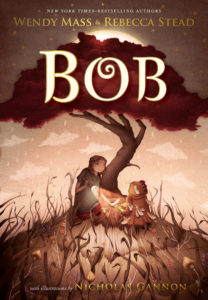craft review by Jen Jobart
Kids do a lot of growing up from ages 8-12. Books are meant to grow with them and inspire them along their journey. A lot of middle grade books have a protagonist whose character arc moves towards independence over the course of the book. The middle grade novel Bob is a good example.
 Bob is a delightful collaboration between Wendy Mass and Rebecca Stead. Bob is a small green creature who has been stuck alone in a closet for years, awaiting the return of Livy, his friend. Livy is visiting her Gran in Australia, for the first time in five years, and finds Bob where she left him the last time she was there, even though she hardly remembers him. Livy is determined to help Bob find his way back to his family.
Bob is a delightful collaboration between Wendy Mass and Rebecca Stead. Bob is a small green creature who has been stuck alone in a closet for years, awaiting the return of Livy, his friend. Livy is visiting her Gran in Australia, for the first time in five years, and finds Bob where she left him the last time she was there, even though she hardly remembers him. Livy is determined to help Bob find his way back to his family.
This story has a strong coming-of-age theme, especially for Livy. I knew that a character had to have an arc, but didn’t know exactly how it mapped out to the external plot points. I took a closer look at Bob to see how the authors mapped out Livy’s internal journey towards independence over the course of the book.
The Hero’s 2 Journeys
To learn how to track a hero’s internal journey across a story, I listened to Chapter 3 of the audiobook The Hero’s 2 Journeys. This is the recording of a lecture that Michael Hauge and Christopher Vogler gave about the internal and external journeys of a story, and how they relate to one another. Chapter 3 is specifically about the internal journey.
Hauge states that in a story, a character moves from identity (how the world sees her) to essence (who she really is). The internal journey is a tug of war between identity and essence. Over the course of the story, the character begins solidly in her identity and makes a gradual shift towards essence.
 The external journey is some sort of adventure. But it turns out that its real purpose is to provide a series of trials that help the protagonist make a gradual shift from identity to essence. As such, each of the external plot points in the Hero’s Journey has a corresponding internal plot point. The external and internal journeys closely intertwine throughout a story. As the stakes of the external plot become more and more dire, the protagonist has to reach within herself to find the strength to face what’s in front of her. The more difficult the trials, the stronger she becomes as a person.
The external journey is some sort of adventure. But it turns out that its real purpose is to provide a series of trials that help the protagonist make a gradual shift from identity to essence. As such, each of the external plot points in the Hero’s Journey has a corresponding internal plot point. The external and internal journeys closely intertwine throughout a story. As the stakes of the external plot become more and more dire, the protagonist has to reach within herself to find the strength to face what’s in front of her. The more difficult the trials, the stronger she becomes as a person.
At the beginning of Bob, Livy feels scared and powerless, and that’s how the world sees her. This is her identity. To help Bob, she’ll need to be brave and independent. This is her essence. But this essence feels uncomfortable to her, so she resists it, just as Bob pushes her toward it out of a need to reunite with his family. The tension between Livy’s identity and her essence is what comprises the internal journey over the course of the book.
Internal journey through the major plot points
In Act 1, a hero exists completely and totally within her identity. In Bob, Livy is terrified of being alone in the world without her parents. She has memories of having to go home early from a slumber party, and worries about whether she’ll be able to cope when her mom leaves her alone with Gran.
The inciting incident gives the hero a glimpse of what life would be like living in her essence. Livy meets Bob and realizes that she can’t tell anyone else about him. She’ll have to figure this thing out on her own. Livy will have to find her internal strength to grow into her essence of an independent, confident young girl.
The beginning of Act 2 is when the hero is presented with a visible goal that will move her from identity to essence. At this point in the book, Livy realizes that five years ago maybe Bob saved her, not the other way around, and vows to save him in return by helping him find his family.
In the first half of Act 2, leading up to the midpoint, the hero has one foot in identity, and one foot in essence. She is aware that she needs to make a change, and is experimenting with how to do it. Livy goes into town with her family, meets Sarah, and picks up on their friendship where it left off 5 years ago. Livy’s mom is still around, but Livy is starting to distance herself from her.
At the midpoint, the hero gets a glimpse of what it would be like to live fully within her essence. She commits to doing so, but there is a major setback and the outside world contrives to keep her from doing so just yet. The midpoint of Bob comes at the end of chapter 9 when Livy realizes she has to help Bob find his family, but has no idea how to do that. It happens with this conversation between Livy and Bob, after Livy’s mom reads a story about a magic well:
“Did you hear that story?” I whisper to Bob when she’s gone. “I wish our well were magic.”
I feel him turn his head, and all I can see in the dark are his big wet eyes.
“I wish I had a mother,” he says.
I don’t know what to say. Bob is alone in the world. Totally, completely alone.
“Bob,” I say finally. “Maybe you do have a mother. Maybe you have a whole big family!”
But he doesn’t answer.
Then Livy’s mom does leave, as she’s been dreading will happen.
In the second half of act 2, after the midpoint, the hero has passed the point of no return and has no choice but to fully commit to living in her essence, but the world isn’t cooperative. In this part of the story, Livy’s mom is gone, and she’s doing okay on her own. Livy knows she has to help Bob and is committed to doing so without anyone else’s help. She realizes she can’t tell anyone else about him, though. So she starts to take action to save Bob, putting his needs over her own fears, little by little.
At the end of act 2, the hero tries one last time to go back to living in her identity, but it doesn’t work. In Bob, Livy and Sarah are hanging out in Livy’s bedroom. Livy tells Sarah about Bob, hoping to convince her to help. But Sara makes fun of Livy for having an invisible friend, and Livy’s last hope for help evaporates.
In Act 3, the hero’s identity is already dead, and she can’t go back. She’s tried and it hasn’t worked. She has no choice but to go forward toward her essence with everything she’s got, but it’s not easy.
In Act 3 of Bob, Livy must face scary things alone in order to finally reunite Bob with his family. Danny goes missing. Gran and Livy go out to search for him. Gran gets tired and falls behind, but Livy sees Bob, and strikes out on her own to catch up with him. They find Danny, who has the book that Mom was reading about the Well Dwellers. Livy, Bob and Danny realize that Bob is a Well Dweller, and that is the key to reuniting him with his family.
In the climax of a story, the hero achieves her visible goal, and in so doing, realizes her essence. There is an All is Lost moment with a setback that appears to be permanent. In order to move beyond the setback, the hero must fully commit to living her essence, and give up the last traces of the idea she has been carrying about who she is.
In Bob’s climax, Bob’s mom appears and is terrifying. She is focused on Livy, and Livy must be brave and face her by herself. Livy steps outside of her fear and offers Bob’s mom the contents of her pockets as a gift so that she will bring rain again. Bob’s Mom takes the black pawn that helps Livy remember Bob. Livy loses Bob, and with the pawn also gone, has no way to even remember him.
By the end of the book, Livy realizes she’s okay, not just without her Mom, but without Bob too. She has completed the journey from her identity (being terrified of being alone) to her essence (being brave and independent).
Incorporating the Internal Journey
I enjoyed studying how Wendy Mass and Rebecca Stead did such a masterful job of moving Livy from identity to essence over the course of the book. I’ve been outlining the next draft of my work in progress, and with this draft, I found I was asking myself not just “What are the major plot points?” but also “How does each plot point affect the protagonist and move her toward her essence?” Asking those two questions together are helping me make sure that both journeys are fully thought out.
Action: Listen to The Hero’s 2 Journeys while you’re stuck in traffic or folding laundry.
Action: Re-read a book that feels satisfying to you, and track how the external and internal journeys work together to build the story.
Action: Track the hero’s journey from your own WIP. How do the main plot points help to transform the hero from identity to essence?
Jen Jobart writes middle grade fiction and is always sending characters she loves on dangerous adventures. She is an active member of the SCBWI and has studied writing for children through Stanford’s Continuing Studies program. When Jen’s not writing, she’s outside gardening and raising chickens at her home in the San Francisco Bay Area. Find her at www.jenjobart.com.


COMMENTs:
0